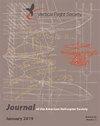Simulation of Rotorcraft Fuselage with Rotor Effects Using an Immersed Boundary Method
IF 1.4
4区 工程技术
Q2 ENGINEERING, AEROSPACE
引用次数: 0
Abstract
Computational fluid dynamics simulations of the flow around the ROtor Body INteraction (ROBIN)-mod7 fuselage with pressure-sensitive paint rotor are conducted using an immersed boundary method and an actuator surface model in OpenFOAM. The ROBIN-mod7 fuselage is represented by the immersed boundary method, while the unsteady rotor is modeled using the actuator surface model. A comprehensive analysis of the generic helicopter configuration is carried out for the hovering flight condition; the isolated fuselage is simulated to provide its baseline aerodynamics, and the isolated rotor and rotor–fuselage cases are studied to measure the rotor performance in hover and the fuselage effect on the performance. The validation of each test case is conducted against both experimental measurements and computational data from the literature. The surface pressure data from the isolated fuselage case shows good agreement with the experimental measurements. Also, the rotor performance predicted on the isolated and installed rotors (rotor–fuselage) has excellent agreement with the reference data; in particular, the performance data on the installed rotor agree with the experimental data better than the previous numerical study does. The fuselage effect has been analyzed by comparing the isolated rotor and rotor–fuselage datasets. The computational effort for different grid levels of each test case is provided. Overall, the results have demonstrated an equivalent level of accuracy compared to the previous high-fidelity simulation results at their fraction of setup and computational expenses.考虑旋翼效应的旋翼机机身浸入边界法仿真
采用浸没边界法和OpenFOAM软件中的作动器表面模型,对带有压敏喷漆转子的ROBIN -mod7型飞机机身周围流动进行了计算流体动力学仿真。ROBIN-mod7机身采用浸入边界法表示,非定常旋翼采用作动器曲面模型建模。对通用直升机构型悬停飞行条件进行了全面分析;对隔离机身进行了仿真,提供了隔离机身的基准空气动力学,并对隔离旋翼和旋翼-机身两种情况进行了研究,测量了悬停时旋翼的性能以及机身对其性能的影响。每个测试用例的验证都是针对文献中的实验测量和计算数据进行的。孤立机身壳体表面压力数据与实验结果吻合较好。对隔离安装后的旋翼(旋翼-机身)进行的旋翼性能预测与参考数据吻合良好;其中,已安装转子的性能数据与实验数据的吻合程度优于以往的数值研究。通过对隔离转子和转子-机身数据集的比较,分析了机身效应。给出了每个测试用例在不同网格级别下的计算量。总的来说,与之前的高保真度模拟结果相比,在设置和计算费用方面,结果显示出相当的精度水平。
本文章由计算机程序翻译,如有差异,请以英文原文为准。
求助全文
约1分钟内获得全文
求助全文
来源期刊

Journal of the American Helicopter Society
工程技术-工程:宇航
CiteScore
4.10
自引率
33.30%
发文量
36
审稿时长
>12 weeks
期刊介绍:
The Journal of the American Helicopter Society is a peer-reviewed technical journal published quarterly (January, April, July and October) by AHS — The Vertical Flight Society. It is the world''s only scientific journal dedicated to vertical flight technology and is available in print and online.
The Journal publishes original technical papers dealing with theory and practice of vertical flight. The Journal seeks to foster the exchange of significant new ideas and information about helicopters and V/STOL aircraft. The scope of the Journal covers the full range of research, analysis, design, manufacturing, test, operations, and support. A constantly growing list of specialty areas is included within that scope. These range from the classical specialties like aerodynamic, dynamics and structures to more recent priorities such as acoustics, materials and signature reduction and to operational issues such as design criteria, safety and reliability. (Note: semi- and nontechnical articles of more general interest reporting current events or experiences should be sent to the VFS magazine
 求助内容:
求助内容: 应助结果提醒方式:
应助结果提醒方式:


